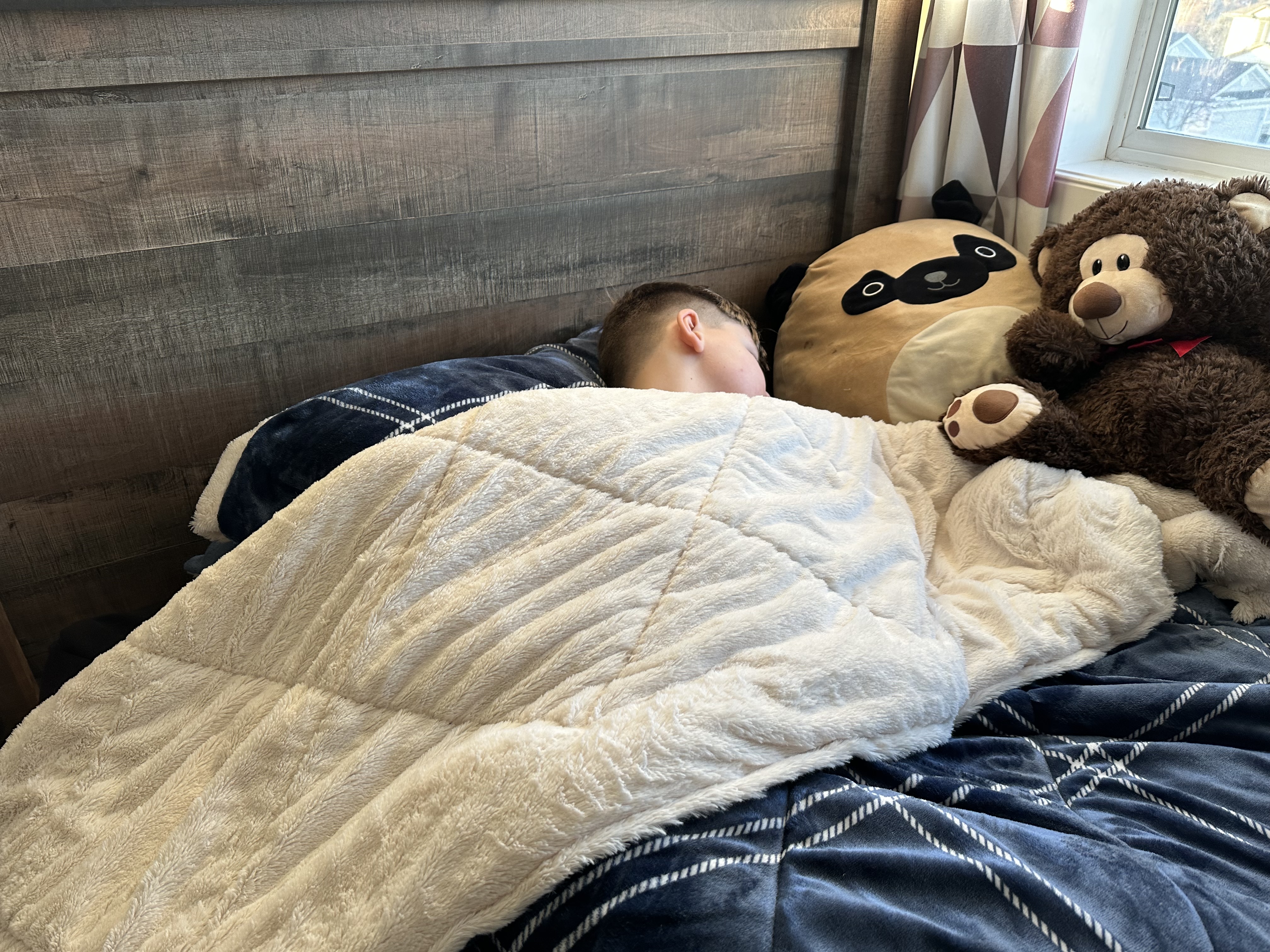Creating a Sleep-Friendly Bedroom for ADHD Children: Tips for Establishing a Sleep Routine

As parents, we all know how important it is for our children to get a good night's sleep. But for children with ADHD, it can be incredibly challenging to establish a sleep routine and create a sleep-friendly bedroom environment.
Our family has experienced this firsthand, and I understand the struggles of creating a peaceful and comfortable space for your child when they have difficulty settling down at night or staying asleep.
The constant movement and impulsivity that are hallmarks of ADHD can make it hard for children to relax and wind down.
But don't worry; I'll share some helpful tips and ideas to make it a reality in this article.
With a little effort, you can create a sleep-friendly bedroom environment to help your child relax, unwind and get the rest they need to thrive.
Why is Getting a Good night's Sleep Important for Kids with ADHD?
A good night's sleep is vital for children with ADHD because it can help improve their attention, behavior, and overall cognitive function.
Adequate sleep can also help reduce symptoms of hyperactivity and impulsivity, which are common with this condition.
Sleep also plays a crucial role in the development of the brain, and lack of it can cause problems in learning, memory, and mood regulation.
Additionally, sleep deprivation can exacerbate existing symptoms and make it more difficult for children to manage the condition.
Ensuring that children with ADHD get enough sleep each night is essential to managing their condition.
What challenges have I faced when Trying to Establish a Sleep Routine?
Children with ADHD may face several challenges when trying to establish a sleep routine, and our family is no exception. Some of the challenges we have encountered are:
- Difficulty falling asleep-my son has had trouble settling down and relaxing at bedtime, which makes it hard for him to fall asleep.
- Difficulty staying asleep- after fighting the battle of initially falling asleep, we also face problems with trouble remaining asleep through the night, resulting in VERY early mornings (yawn)
- Difficulty with sleep-wake cycles- as a result of the previous two points, we find the knock-on effect is that his internal sleep-wake rotation is entirely out of balance, which feeds into the issues above.
- Hyperactivity- The hyperactive tendencies of ADHD make it extremely hard for my son to sit still and relax to prepare for sleep and get comfortable in his bed.
- Impulsivity- this is the most significant contributor to his disrupted sleep. He experiences trouble controlling his thoughts and, therefore, finds it hard to focus on going to sleep.
- Stress and anxiety- I find my son experiences stress and anxiety on a pretty extreme level, making it hard for him to relax and fall asleep.
It's important to understand that every child with ADHD is unique and may face different challenges than what our family has experienced.
Consulting with a sleep specialist or a pediatrician may help to identify and address the specific sleep challenges you may face.
Tips for creating a sleep-friendly bedroom environment
Now, let's talk about a few key things that can help your child get a good night's sleep. We'll cover how to create a cozy and comfortable sleep environment, how to establish a consistent bedtime routine, and a few extra tips to help them drift off peacefully.
Choosing the right bed and bedding:
Choosing the right bed and bedding is essential to establishing a healthy sleep routine. We found out the hard way that the bed and mattress our son was sleeping on were not providing him with the necessary support and comfort for a good night's sleep.
We had to change his bed and adjust the softness of the mattress to a more supportive one. Additionally, we found that switching to soft, fluffy sheets made a big difference in helping him feel comfortable and cozy in bed.
Soft, breathable sheets like cotton or bamboo may also be a good option, as they can keep your child cool and comfortable throughout the night.
If your child uses their bed for reading or non-sleep-related activities, it might be worth creating separate zones for them. Adding a comfy 4 foot bean bag to the space would help divide the area up so your child knows that their bed is for sleeping only.
Implementing a color scheme that promotes relaxation
Implementing a color scheme that promotes relaxation can be highly effective as specific colors have been found to have a calming effect on the mind and body and can help create a soothing and peaceful environment in the bedroom.
Blue, green, and purple colors are known to have a calming effect and promote tranquility and relaxation. Blue is also known to slow heart rate and lower blood pressure, while green is associated with nature and can help reduce stress and anxiety. Purple, a combination of blue and red, is associated with luxury, wisdom, and calmness.
One way we have incorporated these colors into his bedroom is by including them in bedding, curtains, and other decor items. We also opted for soft, muted tones on the walls rather than bright or bold colors that can be too stimulating.
Another way to implement color without changing the entire decor is using color therapy through lighting. We have LED lights around the top of his room and a color-changing lampshade where we can pick a tone that suits his mood.
Controlling light and noise levels
Controlling light and noise levels in the bedroom is also essential to establishing a healthy sleep routine. We have found success by:
- Providing a cool, dark room that mimics a natural sleep environment. Swapped out regular window coverings to black-out curtains/blinds and provided a low-level color-changing nightlight and avoid screens before bedtime to aid the production of melatonin (a hormone responsible for regulating sleep)
- Reducing Noise. Noise can disrupt sleep, especially for children with ADHD. We utilize a white noise machine and encourage noise-canceling headphones- depending on his mood. We also ensure that we avoid noise-generating activities in the bedroom by switching off access to any technology at least one hour before bedtime.
Organizing the space for maximum comfort and ease
It is essential to keep a bedroom clutter-free as otherwise, it can be overwhelming and distracting for a child with ADHD, making it harder for them to relax and fall asleep.
A great way to do this is to encourage your child to keep their room clean and organized by providing them with storage solutions, such as baskets or drawers, to keep things tidy.
Additionally, a wake-up routine involving your child making their bed every morning to create a sense of order in the room will help keep things clean and in order.
Some other points to consider are:
- Arranging the furniture: Organize the bedroom furniture in a way that maximizes the space and makes it easy for your child to move around.
- Ensure the room is well-ventilated: Good airflow is essential for a comfortable sleep environment. Keep the room well-ventilated by opening windows or using a fan.
- Ensure your child has easy access to what they need: Keep items such as a glass of water, books, or a nightlight within easy reach.
Creating a Sleep Routine
Getting a good night's sleep is imperative for everyone, but when many other parts of your day are impacted by managing ADHD symptoms, having a lack of sleep on top can make things ten times worse.
Therefore, it's super important to establish a routine that you can easily follow and will involve the whole family. Once practiced long enough, the way will become a habit and much easier to follow. My top tips and the fundamentals we follow for establishing a good sleep routine are:
- Setting a regular bedtime and wake-up time- This consistent routine can help regulate the body's internal clock and make it easier to transition from wakefulness to sleep.
- Encourage a calm and relaxing bedtime to prepare for a restful night's sleep- this can include activities such as reading, listening to music, or engaging in gentle yoga or meditation/ deep breathing.
- Limiting screen time before bed- Blue light emitted from electronic devices can impact the ability to fall asleep- it's a great idea to limit these activities and shut them off at least 30 minutes before settling down.
- Create a bedtime routine checklist- A bedtime routine checklist can include a series of simple tasks that need to be completed before going to bed, such as brushing your teeth, changing into pajamas, reading a book, and having a glass of water.
When setting the routine that works for you, ensure that you involve your child, as you will find that it will be more well-received and that your child will become excited to put what you have created into practice.
Overall, the main thing to remember is to be consistent with the bedtime routine and to follow it every night, even on weekends. Before you all know it, it'll be second nature!
Additional Strategies that may Help
Additional strategies our family has found helpful to establish a healthy sleep routine for our child with ADHD include:
- Encourage regular exercise: Regular exercise can help tire out the body and make it easier for children to fall asleep. However, avoiding vigorous exercise close to bedtime is important as it can be stimulating.
- Use essential oils: Essential oils such as Chamomile, lavender, and valerian can help to promote relaxation and can be used in a diffuser or added to a warm bath before bed.
- Use a weighted blanket: Weighted blankets can provide security and help children with ADHD relax and fall asleep.
- Practice mindfulness and meditation: Mindfulness and meditation techniques can help children with ADHD focus on the present moment and release any racing thoughts that may keep them awake.
- Keep a sleep diary: Keeping a sleep diary can help parents and children understand their sleep patterns and identify any problems affecting sleep quality.
- Consult with a sleep specialist: A sleep specialist can help to identify and address specific sleep challenges that children with ADHD may be facing and can provide personalized recommendations for improving sleep quality.
Wrap up and my experience with establishing a Sleep Routine for my ADHD child.
It's essential to understand the significance of a good night's sleep for your ADHD child's overall well-being.
We have learned that adequate sleep can improve attention, behavior, and cognitive function in my child and have also noticed a reduction in symptoms of hyperactivity and impulsivity.
Establishing a healthy sleep routine for your child may be challenging, but ensuring they get the rest they need to function at their best is essential.
Parents can set a consistent bedtime, create a relaxing routine, limit screen time before bed, and create a comfortable sleep environment.
It's important to remind parents that the process of establishing a healthy sleep routine may take time and that it may require patience and persistence.
Remember to be consistent in your efforts and be open to adjustments.
A restful good night's sleep is important for your child's well-being, and with time, effort, and the proper support, you can help your child establish a healthy routine.
I wish you lot’s of great sleep from here on out!
-----------------------------------------------------------------------------------------------------------------------------
Gemma Anne Smith
Founder at: gemmaannesmith.com
Bio: As a mom of three, including two children with special needs, and owner of two successful handmade businesses, Gemma brings valuable experience and a unique perspective to her work. In addition to her professional pursuits, Gemma is dedicated to helping others succeed by sharing her knowledge and expertise at www.gemmaannesmith.com






